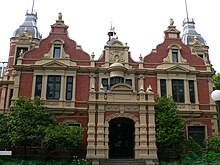Melbourne Teachers' College: Difference between revisions
m Pic |
No edit summary |
||
| Line 1: | Line 1: | ||
'''Melbourne Teachers' College''' was a tertiary training institution located in Grattan Street, Carlton. It was renamed Melbourne State College, and then Melbourne College of Advanced Education. In 1989 it became part of the [[University of Melbourne]].<ref>http://archive.uninews.unimelb.edu.au/news/871/</ref> |
'''Melbourne Teachers' College''' was a tertiary training institution located in Grattan Street, Carlton. It was renamed Melbourne State College, and then [[Melbourne College of Advanced Education]]. In 1989 it became part of the [[University of Melbourne]].<ref>http://archive.uninews.unimelb.edu.au/news/871/</ref> |
||
[[File:Melbourne university 1888 buildings.jpg|thumb|The 1888 building]] |
[[File:Melbourne university 1888 buildings.jpg|thumb|The 1888 building]] |
||
Revision as of 02:14, 13 June 2013
Melbourne Teachers' College was a tertiary training institution located in Grattan Street, Carlton. It was renamed Melbourne State College, and then Melbourne College of Advanced Education. In 1989 it became part of the University of Melbourne.[1]

Gryphon Gallery, 1888 Building
During the 1970s and until 1994 the Gryphon Gallery, in the 1888 Building, exhibited art by College Lecturers. It was a condition of employment that lecturers in Art and Drama were required to be practicing exhibiting artists.
In 1977 Noel Flood (Head of Department Ceramics) and John Teschendorff (Lecturer Ceramics) held a two man show titled 'Recent Handcrafts and Other Objects,' making a mocking reference to the popular view at the time of pottery as craft. [2] The Gryphon Gallery also exhibited student work.
The 1888 building housed the Melbourne Teachers’ College until 1994. Features include stained glass windows and ceramic tiled portraits commemorating those staff and students who served in the First World War. [3] The stained glass windows include a roll call of those staff and students, they have been photographed. [4]
References
- ^ http://archive.uninews.unimelb.edu.au/news/871/
- ^ Exhibition Opening Invitation. 18/07/1977. State Library of Victoria.
- ^ http://lostoncampus.com.au/25414
- ^ http://empirecall.pbworks.com/w/page/54038799/Teachers'%20College%20Memorial%201914-1918
